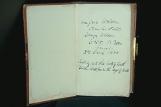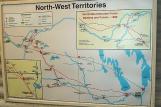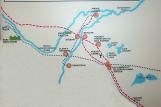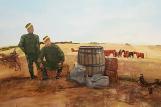14
The hearth was a central part of making the Humboldt Telegraph Station a home. Keeping the woodpile stocked was a full time job for George. Catherine was known for her hospitality, and with the kettle on the stove, was ready to serve the weary traveler a hot cup of tea.16
This is the bible that belonged to Ann Jane (Birdie) Weldon. Her father, George, wrote the following dedication inside:"Ann Jane Weldon
Canada, 2nd March 1878
So study well this book of truth, it will bless you in the days of youth."
The bible was donated to the museum by Janet Hooke, great granddaughter of George and Catherine Weldon.
20
Humboldt Telegraph Station exhibit at the Humboldt and District Museum and Gallery.2003
Humboldt, Saskatchewan, Canada

21
A telegraph station consists of:- a direct power source, usually a battery
- a sounder, which consists of an electro-magnet and armature
- a key, which serves to open and close the circuit
A telegraph key and receiver are electronic devices that provide the means to communicate over great distances. All communication systems consist of a transmitter, receiver, and a medium. In telegraphy an electrically conducting wire serves as the medium. Messages are encoded and transmitted as electrical signals. The signals are generated by simply opening and closing the circuit, joining the receiver and transmitter.
When a telegraph key is connected to wire and batteries, it can send electrical impulses over wire great distances. This machine can send only clicks, not words, but by using Morse code, messages can be passed from one telegraph station to the next.
22
Humboldt Telegraph Station exhibit at the Humboldt and District Museum and Gallery.2003
Humboldt, Saskatchewan, Canada
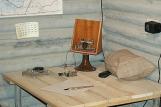
23
The Morse code is a language based on two types of clicks: short clicks (dots) and long clicks (dashes) invented by a man by the name of Samuel Morse. Morse gave all the letters of the alphabet specific click combinations. He learned which letters of the alphabet were used most frequently in the English language and assigned these letters the simplest click combination. E, for example, is just one click.A person who was trained to use the Morse code, such as a telegraph operator or lineman, would send or relay messages at a telegraph station.
One of the cheapest and fastest way of sending messages was using the telegraph key system - others ways were by mail or pony express.
25
Lt. Colonel George Denison recounts his time at the Humboldt Telegraph Station."We reach Humboldt on the night of May 1st, 1885, after marching four days from Qu'Appelle. My instructions were to remain at Humboldt and await further orders. I am in charge of guarding stores and cavalry for General Middleton.
Our position is on an open rolling prairie, open for miles to the north in the direction of the enemy who were at Batoche. I was left with about ninety cavalry to guard all the stores which were pouring in every day. I knew the cavalry could not act on the defensive mounted, and therefore would be forced to act as an infantry.
I went out on to the open rolling prairie and six hundred yards from the station I found two knolls close together, about eight feet high, with a dip between them. Here I pitched my camp."
26
Soldiers at Humboldt Telegraph Station during the Batoche uprising2003
Humboldt, Saskatchewan, Canada
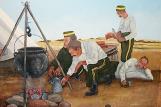
27
Lt. Colonel George Denison recounts his time at the Humboldt Telegraph Station."I began the first night to dig rifle pits to shelter the men, I kept enlarging and connecting them and deepening the ditches in front. The interior ditch is two feet deep, the exterior one about four feet. The men have named our camp Fort Denison."

